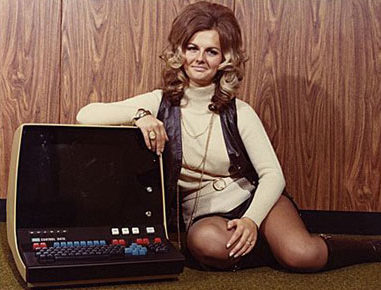Computer matchmaking dates back long before “Language Style Matching,” all the way to the 1950s, in Canada at least, when singles experimented with IBM punch-card yenta-ing. It was, as you might guess, rudimentary, as hook-ups encouraged by the machines (based largely on height and age and hair color) still had to be arranged via rotary phone. By 1966, Gene Shalit and his mustache headed to Harvard to report for Look magazine on a computer-enabled, pre-Tinder bacchanal sweeping elite American colleges. The opening of Shalit’s Borscht Belt-New Journalism mashup for the long-defunct title:
Out of computers, faster than the eye can blink, fly letters stacked with names of college guys and girls–taped, scanned, checked and matched. Into the mails speed the compatible pairs, into P.O. boxes at schools across the land. Eager boys grab their phones… anxious coeds wait in dorms … a thousand burrrrrrrings jar the air . . . snow-job conversations start, and yeses are exchanged: A nationwild dating spree is on. Thousands of boys and girls who’ve never met plan weekends together, for now that punch-card dating’s here, can flings be far behind? And oh, it’s so right, baby. The Great God Computer has sent the word. Fate. Destiny. Go-go-go. Call it dating, call it mating, it flashed out of the minds of Jeff Tarr and Vaughn Morrill, Harvard undergraduates who plotted Operation Match, the dig-it dating system that ties up college couples with magnetic tape. The match mystique is here: In just nine months, some 100,000 collegians paid more than $300,000 to Match (and to its MIT foe, Contact) for the names of at least five compatible dates. Does it work? Nikos Tsinikas, a Yale senior, spent a New Haven weekend with his computer-Matched date, Nancy Schreiber, an English major at Smith. Result, as long date’s journey brightened into night: a bull’s-eye for cupid’s computer.•
Holy fuck, someone should have punched Gene Shalit right in the handlebar. Interesting though, despite the woeful writing, is that proto-Zuckerbergs were climbing the Ivy 50 years ago, trying to transform strange faces into friends. In a decade, “smart” romance had been monetized and become somewhat more sophisticated, but Moore’s Law clearly had a ways to go before it could truly be brought to bear on mating.
While today’s dating apps are much more algorithmically adept, it still feels like we’re in the early stages of machine-assisted love. Will the continuous development of language analysis and AI “eyes” be able to identify our cues even before we do? What does love at first sight mean in an age of visual-recognition systems?
In “When Dating Algorithms Can Watch You Blush,” Julia M. Klein’s smart Nautilus piece, the reporter looks at the next-level work of Northwestern psychologist Eli Finkel, who acknowledges it’s unlikely there is “ever going to be an algorithm that will find your soul mate.” He’s just hoping for significant if incremental improvement. The opening:
Let’s get the basics over with,” W said to M when they met on a 4-minute speed date. “What are you studying?”
“Uh, I’m studying econ and poli sci. How about you?”
“I’m journalism and English literature.”
“OK, cool.”
“Yeah.”
They talked about where they were from (she hailed from Iowa, he from New Jersey), life in a small town, and the transition to college. An eavesdropper would have been hard-pressed to detect a romantic spark in this banal back-and-forth. Yet when researchers, who had recorded the exchange, ran it through a language-analysis program, it revealed what W and M confirmed to be true: They were hitting it off.
The researchers weren’t interested in what the daters discussed, or even whether they seemed to share personality traits, backgrounds, or interests. Instead, they were searching for subtle similarities in how they structured their sentences—specifically, how often they used function words such as it, that, but, about, never, and lots. This synchronicity, known as “language style matching,” or LSM, happens unconsciously. But the researchers found it to be a good predictor of mutual affection: An analysis of conversations involving 80 speed daters showed that couples with high LSM scores were three times as likely as those with low scores to want to see each other again.
It’s not just speech patterns that can encode chemistry. Other studies suggest that when two people unknowingly coordinate nonverbal cues, such as hand gestures, eye gaze, and posture, they’re more apt to like and understand each other. These findings raise a tantalizing question: Could a computer know whom we’re falling for before we do?•

